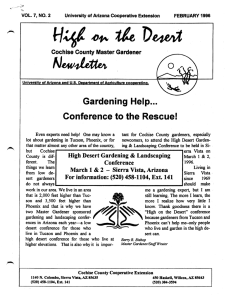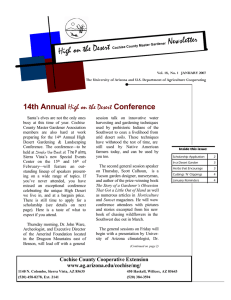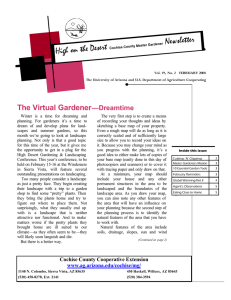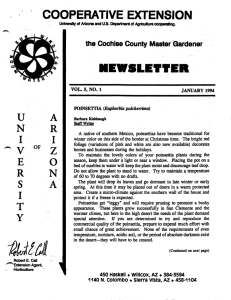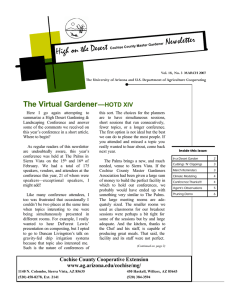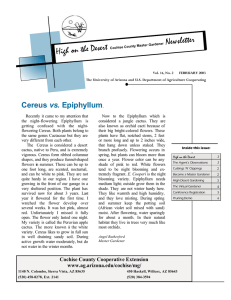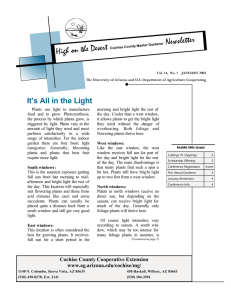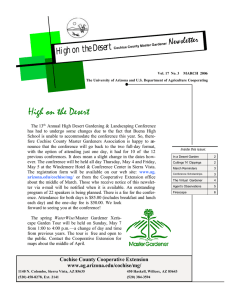PEOPLE PROFILE- Gardeners Cochise County Master Gardener
advertisement
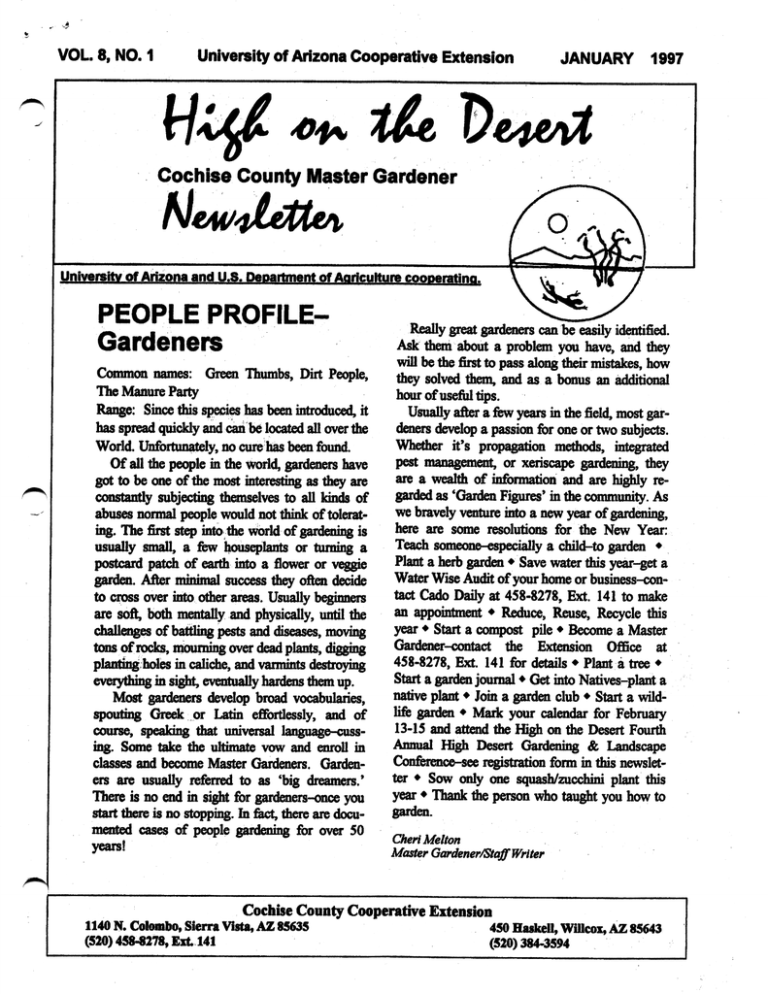
VOL. 8, NO. 1 University of Arizona Cooperative Extension JANUARY 1997 Cochise County Master Gardener Universitv of Arizona and U.S. Department of Agriculture cooneratinn PEOPLE PROFILEGardeners Ganmon naims: Green Thumbs, Dirt Pe(q>le, The hfemire Party Range: Since tiiis si:^^ has beatinOoduced, it has spread quiddy and cah be locatedall overthe World. Unfortuiudely, no cure has been fouiul. Of all the people in the worid, gardeners have got to be one of the most interesting as tiiey are amstantly subjectii^ themselves to all kin^ of abuses normal people would not think oftderat- h^. The first stq> into the Worid of ^uxteiiQg is usually small, a few housqilaitts or turning a postrard patch of earth into a floww or veggie gar^. A^r minimal success they ofien decufe to orss over iitfo otiier areas. Usually beginners ate soft, botii mraitally and physically, until the challenges of battlingpests and diseases, moving tons ofrodks, mourning overdead plants, di^giiig planthighdi» in calidie, and varmints destrcqdng everytiupg in si^ eventually hardens than up. Most gardeners devel(^ broad vocabularies, spoutmg Gredc or Latin efifertlessly, and of course, speaking that universal language-cuss ing. Smne take the ultimate vow and ouoll in classy and bec(»ne Master Gardeners. Garden ers are usually referred to as 'big drramers.' Hmre is no end in si^ for gardenov-tmce you start there is no stopping, fo feet, there are documoited cases of people gardening £br over SO ymirs! Really great gardenem canbe easily identified. Ask them about a problon you have, and they will be the first to pass altmg tiieirmistalms, how tlmy solved them, and as a bonus an additional hmirofusefultips. Usually after a fewyears in tlm field, mostgar- ^lers develop a passitm for <nie or two subjects. Whetl^ it's pn^nigation methods, int^rated pest mana^mmit, or xerisctqm gardenmg, they are a wealth of infinmation and are highly re garded as 'Garcten Figures' in the community. As webravely venture intoa new year of gardening, here are some resolutions fi>r the New Year; Teach someoim-especially a diild-to ^uden * Plant a herb gardmi * Save water thisyear-get a WaterWiseAudit ofyourhome or business-con tact Cade Daily at 4S8-827S, Ext. 141 to make an appointmmit * Reduce, Reuse, Recycle this year ♦ Start a compost pile * Becmne a Master Gardmrer-contact the Extensicm OfBce at 458-8278, Ext. 141 for details ♦ Plant a tree ♦ Start a gatdmi journal * Getinto Natives-plant a nativeplant * Join a garden club * Start a wild life ^rdm ♦ Mark your caloidar for February 13-15 and attend tiie FGgh cm the Desert Fourth Annual High Desert Gardraung & Landscape Conference-see registration form in tins newslet ter * Sow only one squash/zucdiini plant this y^ * Thank tte person vbo taught you howto ^udmi. Chert Melton Master Gctrckner/^tiffWriter Cochise County Cooperative Extension 1140 N. Cdombo, Sierra \lstat AZ 8S(3S (520) 458^78, ExL 141 450 HaskeU, WUIcox, AZ 85043 (520)384^594 Ifyouhave evertried to lookup the name of a plant in a standard The Virtual Gardener- bontanical reference book you have probably run into the thicket of specialized terms used to de scribe the shapes of various plant parts. The oth^ day I ran across a Botanical Nomenclature quiz onthe California Native Plant Society (CNPS) Web site (http://www.calpoly.edu/~dchippin/cnps_main.html) which should help you learn the names applied to the shapes of plant leaves. See how many you can correctly name without peeking atthe answers. To give you some help in identifying the leafshapes in the quiz, I used an on-line dicationary athttp://www.bucknell.edu/~rbeard/diction;html to look up the Latin and Greek roots ofthe toms. Here they are: • Linear line-diaped •Peltate armed with a shield •Lanceolate lance-shaped • Oblong rather long • Oblanceolate inversely lanced-shaped • Spatulate shapedlike a small spade • Peifoliate through the leaf • Obovate inverselyegg-shaped •Ovate egg-shaped • Deltoid delta-shaped • Elliptical sht^ed like an ellipse • Orbicular orb-shaped •Cuneate wedge-shaped Recordyour answers in die table below. Answers I '-o-oi '<1-6 ii-8 iH-9 5a-s iw-t ^o-c '•a-t tv-t Gary Gruenhagen (gruenha@c2i2.com) Master Gardener Cuttings 'N' Clippings Bishic^ Room of the Sierra Vista Library. Ext^ion Agent, Rob Call, will be presentiirg a pn^iam offered f(Mr free at the Desert Gardening & Lands^ping C(»iferrace on Fdiniary 13 ami 14. The > The next meeting of the Sierra are oicouiaged to bring in your ex Vista Area Gardtmer's traseeds (all kinds) for a s^ bag public is cordially invited to attend the garden dub meetiiigs. If you have any (piestions, c(Mitact Jena ging project. The seeds will be Bamett at 378-9625. (Ml How to Prune Your Trees. You Club is Januaiy 16, 2:00 pm at the Mona Page! Full Conference: $60.00 Includes both day sessions, 2 breakfasts, 2 lunches, & closing reception -OH One Day: $40.00 Includes one day sessions, 1 breakfast, 1 lunch, & closing reception, ifFriday Register by January 31,1997 to avoid late charge: $70.00 full - $45.00 one day H^h Desert Gardening Windemere Hotel Landscaping Conference Conference Center 2047 S. Hwy 92 Sierra Vista, AZ 85635 (520) 459-5900 is offering special room rates for conference participants. Please make reservations with Windemere Hotel and ask for Master Gardener Conference rate. 1-800-825-4656 ( \ Fourth Annual February 13-15,1997 Windemere Hotel and Conference Center Sierra Vista, AZ Sponsored by: Cochise County Master Gardeners Association in conjunction with The University ofArizona Cooperative Extension ( 1997 Conference Program ttt Conference Registration Thursday, February 13 7:30 - 8:45 am 9:00-10:15 am General Session Regjstration and Breakfast Date 8:45 - 9:00 am Welcome 9:00 -10:15 am General Session Name Address City_ _State Telephone Full Conference $60.00 10:30 -11:45 am Nursery Owner Marti Murphy, Arizona State Parks Environmental High Desert Landscaping Education Karchner Caverns State Park 11:45 -12:00 pm Resource ConservationService, USDA WaterHarvesting 12:00 -1:30 pm Lunch, Door Prizes & Exhibits 1:45 - 2:45 pm SesdonlV Exhibits 12:00 -1:30 pm One Day $40.00 (AfterFeb. 1 $45.00) 1:45-2:45 pm Amount Enclosed Please make checkpayable to: Cochise County Master Gardeners Assn. General Session Geoff Parker, District Conservationist with Natural 11:45 -12:00 pm (AfterFeb. 1 $70.00) The University of Arizona and Author Insects ofthe High Desert Judith Phillips, Landscape Designer, Author, and 10:30 -11:45 am General Session Zip_ Carl Olson, Associate Curator ofEntomology, Lunch, Door Prizes & F.Thihit« A Elizabeth Davison, Propagation bySeed* B. CathyWertz,Planting a Wild/lowerMeadow C. JimmyTipton, Propagationby Tissue Culture Session I A. Rob Call,Successjul Vegetable Gardening* B. Kim McRqmolds, Native Grasses and Wildlife C. Gary Woodard, J.D., M.P.P. &Patsy Waterfall^ Media Toolsfor Promoting Desert Landscaping 3:00 - 4:00 pm Exhibits 3:00 - 4:00 pm Session V A. Brad Marshall, Drip Irrigation* B. Sheri Williamson, Gardeningfor Southwestern Wildlife C. Fun and Profitfiom Hardshell Session VI Session n 1140N. Colombo A Jan Groth, Container Gardening* B. MarkDouglas, Growing Tree Fruit 4:15 - 5:15 pm Sierra Vista, AZ 85635 C. Steve Enteman, Pond Construction and A. John Begeman, Dispelling Common Gardening Cochise County Master Gardeners Association Maintenance. ,To help with our planning, please indicate preference for each session: A A A B B B C C C 1 A A A B B B C C C _I would like toattend Saturday Workshc^ _I would liketo attend Saturday Tour For information please call: The U. ofA. Cooperative Extension OfBce Sierra Vista, AZ (520) 458-8278, Ext. 141 4:15- 5:15 pm Session HI A. Cado Daily, "WaterWise" Conservation* B. Robert Smith, Ph.D., rcr#n/tes-^r/dLand Decomposers B. JimmyTiptoa, Water Use ofNative Trees C. Peter Gierlach, Going Wild-Growing Native: A Design Course by Mother Nature 5:30 - 7:00 pm Reception C. John White,Nutsfor the Home Garden Saturday, Februaiy 15 Friday, February 14 7:30 - 8:45 am Registration and Breakfast 8:45 - 9:00 am Welcome NOTE; A Workshq) with Cado Daily-10:00am Implementing a WaterAudit B. Tour of Sierra Vista Compost Facility-9:00 am * Denotes Basic Gardening Session SPEAKERS AND TIMES SUBJECT TO CHANGE WITHOUT NO n- The Agent's seclusion. Keep the soil drier than normal. Once flower buds are set plant and help maintain a healthy plant during the holidays. During Observations you can cease this practice and in the winter nwnths with less sun crease watering. light and cooler indoor tempera Source: Housepkmts, The Ameri can Horticultural Sod^, 1980, 1^.81 and 85. tures plant growth will be slowed, Q My Christmas Cactus did not bloom this year. Whath^pened? A "holiday" cacti. They There are several are Christmas Cactus, Schumbergera hridgesii, with smooth leaf mai^gins or edges; Thanksgiving Cactus, S. truncata, ^ch blooms earlier and has saw-tooth leaf mar gins and two oppositely pointed tips at the endof each leaf; and the Easter Cactus, S. Gaertneri, which blooms naturally in the spring and has smooth leaf margins. These cacti species originated from the Brazilian jungleand grownaturally as epiphytes (in the air) in the branches and bark of trees. (See December 1996 High on the De sert Newsletter for more information.) These plants are short-day plants like poinsettias. Flowering is initi ated by cool temperatures, 45° to 55° F, drier soil, and the naturally shorter days of spring or fall. The Christmas Cactus in question did not bloom because one or more of these conditions were not met. To induce flowering, determine what type of cactus species you have. Ten weeks before blooms are desired, place the plant in a cool closet or dark cupboard from sun down to sunup, never letting any light reach the plant during therefore the amount of fertilizer should be decreased as well. What should I do to Q keep my poinsettia blooming and growing throughout the year? A Poinset ia, Euphorbia pulcherrima, is a tropical plant that originated in Mexico. Members of Euphorbia pulchei the Euphorbia fiunily have white latex sap. Light requirements are bright After the colorful bracts (we think ofthem as flowers) fell, place but not direct sunlight. Dim light or the plant ina cool room and let the darkness will shorten its life. These plants should be watered when the soil stay nearly dry until spring. Repot the plant in new soil and cut soil surface feels dry to tiie touch. back the stems to six inches above If a poinsettia is allowed to wilt its life span will be shortened. Water ing should insure that the entire the pot rim. Then move to a sunny root ball is moistened. Poinsettias should not be allowed to sit in wa centration to 1/4 to 1/2 strei^th ter because their roots are very prone to root rots. Ideal tempera ing back terminal growth encour ages branching and more blooms. ture should never exceed 72° F Poinsettias are short-day plants; during the day or 65° F at night. meaning that flowering is induced Plants do well in high humidity en vironments. Low humkiity and as day lengths shorten. To insure return holiday blomns keep in ab location, water well, and watch for new growth. Increase fertilizer con- and apply at each waterii^. Pinch temperatures over 75° F are detri solute darkness from sundown to mental to the plants. Beware of sunup for ten weeks beginning in placing plants near heat vents, on top of televiskms, or in areas that October. If this is too much work, the old plant can be discarded and are drafiy or have sudden changes a new one purchased for the next from hot to cold. Concentrations of holiday season. 1/8 to 1/4 of rectmumndedstrength houseplant fertilizer applied at each watering will "spoon-feed" the Robert E. Call Exten^on Agent, Horticulture Director, Cooperative Extension, College ofAgriculture, The University ofArizona Md Araona Countiw coopenrhi® Ths ^ oppcTtuniiy employer widtori»d to provide research, educational irtfom^tm art other services only to individuals and msUtutions that fimcbon without regard to Vfilerao's status, or « « • • • The iidbimation given herein issuppliedvrithdie tmdeistaddingtlrt no diacfimnialion biittendedand no mdonement byCoqieMUve Extension Min^thed.. itayprodu(d8.aefvice8.ororgani2a&««tlrta«inenlion«d,diov»n,orindirectlyiinptiedffldmpubUcatk»donotiiig>lyendorseineiilbylliBOnhwrtyrfAnzona. rdt&Hm.ooksr. national <mgiii, agjS* Vietnam Pate 5 BULK RATE COOPERATIVE EXTENSION POSTAGE & FEES PAID U.S. DEPARTMENT OF AGRICULTURE USDA THE UNIVERSITY OF ARIZONA PERMIT No. G268 TUCSON, ARIZONA 85721 OFFICIAL BUSINESS PENALTY FOR PRIVATE USE $300 •ei* tU- Happy New Year & The Cochise County Master Gardeners Association in conjunction vvith The University of Arizona Cooperative Extension is busy planning their Fourth Annual High De sert Gardening & Landscaping Conference to be held Feb Happy Gardening! ruary 13-15 at the Windemere Hotel and Conference From the volunteers that bring you The Cochise County Master Gar dener Newsletter as we begin our Center in Sierra Vista, AZ. The past three conferences have S* year of publication. been very successful and the 1997 conference promises to be even more exciting. This is an educational, fiin experi ence for anyone and everyone with an interest in gardening. Plan now to attend! A registration form is included in this /newsletter. If you have any questions, please call the Coop- eijatiye Extension Offices at the numbers listed on the froht lofthis publication. Newsletter Staff: Carolyn Gruenhagen Barbara Kishbaugh Cheri Melton Virginia Westphal 4/c Robert E. Call, Extension Agent, Horticulture
